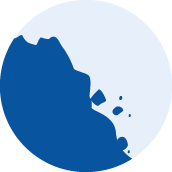TsunamiNgaru taitoko
All of New Zealand’s coastline and large lakes are at risk of tsunami. Knowing the warning signs and the right action to take can help save lives. Find out what to do before, during and after a tsunami.
On this page
Remember: Long or Strong, Get Gone
(The words ‘When an earthquake happens’ are floating on screen. But a sudden shaking breaks them and they fall to the ground.)
When an earthquake happens, you need to think. Is it hard to stand up?
(A figure stands next to the floating words ‘Is it hard to stand up?’. But the ground starts shaking and the words break and fall to the ground. The figure drops to their hands and knees and covers their head with their hands.)
Or has it lasted longer than a minute?
(The figure on the floor stays where they are while the words ‘Or has it lasted…’ appear on screen. The figure raises their head while the words ‘… Longer than a minute’ also appear. The words tick down from the top of the screen like the hand of a clock.)
(A picture of a hill with some houses on it now fills the screen. The ocean is at the bottom of the hill.)
Then, if you’re near the coast…
(A location pin hovers above the lowest house.)
… Move immediately to the nearest high ground…
(The ocean becomes a tsunami wave sweeping across the hill. The location pins flies up to the top of the hill out of range of the water.)
… Or as far inland as possible.
(The ocean disappears and the hill falls away to flat land with some houses on it. The location pin is over the house on the far left. The location pin flies off to the right leaving the houses behind.)
(The location pin disappears leaving a figure standing on the ground.)
Don’t wait for an official tsunami warning.
Go immediately.
(The words ‘Go immediately’ appear and bump into the figure causing them to run off screen.)
(The figure is now on top of a hill with their family.)
Then stay there until you’ve been given the all clear.
(A thumbs up icon appears next to the family.)
If an earthquake is Long or Strong, Get Gone.
(The Civil Defence logo appears on screen. The words ‘Long? Or Strong Get Gone’ appear underneath, followed by the url www.civildefence.govt.nz)
If an earthquake is Long or Strong: Get Gone.
Move immediately to the nearest high ground or as far inland as possible. Don’t wait for an official tsunami warning.
About tsunami
In New Zealand, we have a lot of natural hazards. Earthquakes, floods, landslides, severe weather, tsunami, volcanic activity, and other hazards can happen any time and often without warning.
All of New Zealand’s coastline is at risk of tsunami. Knowing the warning signs and the right action to take can help save lives.
You can reduce the impacts of tsunami by finding out your tsunami risk. Your Civil Defence Emergency Management Group has tsunami evacuation zone maps and advice. Make sure you know where to go, whether you are at home, at work or out and about.
You should also review your insurance regularly. Having insurance cover for your home and contents is important to help you get back on your feet if you suffer damage in a disaster.

We can't predict disasters, but we can prepare for them. One of the best places to start is with your home. Find out what you can do to make your home safer.
Get ready before a tsunami
Get ready before a tsunami.
- Work out what supplies you may need and make a plan with your whānau.
- Know your tsunami evacuation zones. Make sure you know where to go, whether you are at home, at work or on holiday. Your local Civil Defence Emergency Group has tsunami evacuation zone advice.
- Understand the different types of warnings: Natural, Official and Unofficial.
- Regularly practise your tsunami hīkoi (evacuation walk).

Make a plan online with your whānau to get through an emergency. Think about the things you need every day and work out what you would do if you didn't have them.

Your Civil Defence Emergency Management Group has tsunami evacuation zone maps and advice. Make sure you know where to go, whether you are at home, at work, or out and about.

In an emergency, you may be stuck at home for three days or more. Your house is already full of emergency items disguised as everyday things. Figure out what supplies you need and make a plan to get through.
Tsunami Hīkoi
If you are in a tsunami evacuation zone, you should practise your evacuation route, or ‘tsunami hīkoi’. A tsunami hīkoi is a walk that takes you along your tsunami evacuation route either inland or towards high ground.
Practicing your tsunami evacuation route helps your muscle memory kick in when an event happens, even in a very stressful situation.
Check to see if your home, work, school or community meeting place is in a tsunami evacuation zone. Plan a route that takes you safely out of the zone. Plan to walk or bike if you can. Your Civil Defence Emergency Management Group has tsunami evacuation zone maps and advice.
Decide where you will go (and make sure everyone in your family knows, in case you’re not all together). Your evacuation place will probably be with friends or family, so make sure they know your plans.
Practise your tsunami hīkoi with your family, colleagues or classmates. Tsunami hīkoi week and ShakeOut are great opportunities to practise. If you have a pet you could walk them along your tsunami evacuation route.

Download East Coast LAB's tsunami hīkoi information sheet. Organise a community tsunami walk.

Download East Coast LAB's tsunami hīkoi poster. Show you're taking part and help spread the word.

Visit the East Coast LAB website to find out about Tsunami Hīkoi Week.
Natural tsunami warnings
Know the natural warning signs and take action. For a local source tsunami, which could arrive in minutes, there won’t be time for an official warning. It is important to recognise the natural warning signs and act quickly.
Drop, Cover and Hold if there is earthquake shaking. As soon as the shaking stops, move immediately to the nearest high ground or as far inland as you can out of tsunami evacuation zones. Even if you can't get out of your evacuation zone, go as far or as high as you can. Every metre makes a difference.
Take action if you are near the shore and see a sudden rise or fall in sea level or feel a strong earthquake that makes it hard to stand or a long earthquake that lasts more than a minute. Do not wait for official warnings.
Remember, if an earthquake is Long or Strong, Get Gone.
Walk, run or cycle if at all possible to reduce the chances of getting stuck in traffic congestion.
Take your animals with you only if it will not delay you. Do not spend time looking for them and if you are not at home, do not return to get them.
While evacuating, avoid hazards caused by earthquake damage, especially fallen power lines.
Do not return until you get an official all-clear message from Civil Defence.
Official tsunami warnings
When tsunami travel across the ocean from far away, we have more time to warn people what to do.
Civil Defence issues tsunami warnings in New Zealand.
Tsunami warnings are published on the National Emergency Management Agency's website. Tsunami warnings will also be broadcast on radio and television. An Emergency Mobile Alert may also be issued if there is a threat of flooding of land areas.
Warnings may also be broadcast through:
- siren
- phone
- mobile text
- loud hailer, or
- other local arrangements.
Contact your Civil Defence Emergency Management Group for more advice. They can tell you about the warnings used in your area.
Immediately follow the advice of any emergency warning. Do not wait for more messages before you act.
Unofficial or informal tsunami warnings
You might receive informal tsunami warnings. Informal warnings could come from:
- friends
- other members of the public
- international media, and
- the internet.
If the warning seems trustworthy, consider evacuating. Check the accuracy of the warning once you have evacuated or en route if it won't slow you down.
If official warnings are available, trust their message over informal warnings.

Find your local Civil Defence Emergency Management (CDEM) Group.
Lake tsunami
Tsunami can happen in lakes and other large bodies of water. They can be caused by:
- Earthquakes,
- landslides,
- rock falls,
- volcanic eruptions,
- dam failures, and
- glacier collapses.
Even a small earthquake could trigger a landslide at a mountain lake and create a tsunami.
It’s important to recognise the natural warning signs and act quickly.
If you are at a lake or any other large body of water and experience any of the following, move away from the water's edge to higher ground immediately.
- Feel a strong earthquake that makes it hard to stand up. Or a long, weak, rolling earthquake that lasts a minute or more. Remember: Long or Strong, Get Gone.
- See a sudden rise or fall in water level. Or see unusual waves or water behaviour without an obvious cause.
- See indications of landslides or rock falls.
- Hear loud and unusual noises from the water or surrounding area.
What to do after a tsunami
After a tsunami, only return home once you are told it is safe to do so.
Follow your Civil Defence Emergency Management Group online. They will give you information and instructions.
If you felt an earthquake, expect more shaking. More earthquake shaking may generate another tsunami. Be prepared to evacuate.
Stay away from coastal water, tidal estuaries, rivers and streams for at least 24 hours after any tsunami or tsunami warning. Even small waves create dangerous currents.
Avoid areas impacted by the tsunami. You might hamper rescue and other emergency operations and be at further risk from the residual effects of tsunami flooding.
Help others if you can, especially people who may need extra help.
If your property is damaged:
- Do not do anything that puts your safety at risk or causes more damage to your property.
- Contact your insurance company as soon as possible.
- If you rent your property, contact your landlord and your contents insurance company.
- Take photos of any damage. It will help speed up assessments of your claims.

First aid saves lives. Learn what to look for and what to do if you need to give first aid on the St John website.
Resources

Download and print this poster in English. Put it up in your home, school, work or community space. Remember if an earthquake is LONG or STRONG, GET GONE.

Download and share this factsheet in English about what to do before, during and after a tsunami.

Learn about our tsunami monitoring and warning system. This guide has been developed for Mayors and people working in local government.
Types of hazards | Ngā momo matepā
In New Zealand we have a lot of natural hazards. Find out what to do before, during and after each type of emergency.









